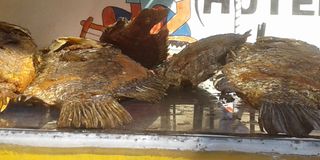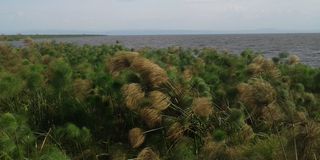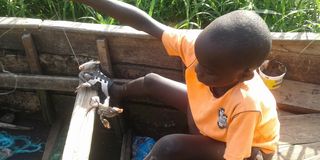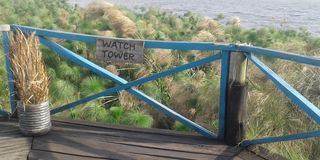Watch conservation in action at Lake Victoria’s Papyrus Swamp

Local restaurant at Dunga Beach near the papyrus walkway with fried tilapia . Photo | Rupi Mangat
What you need to know:
- Standing high on the platform at the end of the walkway with the endless blue water rimmed with green, we’re treated to the snowy Great white egrets
- This wetland is an important carbon sink
A few minutes down the new tarmac road from the lakeshore city of Kisumu, we’re at Dunga Beach by the enormous fish sculpture made of waste material found on the beach to mark Flipflopi’s entry into Kisumu, to do away with single-use plastic that is a noxious pollutant. Flipflopi is the world’s first life-size dhow made of 100 per cent recycled plastic trash and recently completed its sail around the lake to raise awareness about plastic pollution.
It’s a bustling place with the fish market, fish eateries and fishers’ canoes docked on the beach.
The two guides, Tom Mboya and John Raila of Friends of Dunga Swamp Conservation Site Support Group guide us on the raised walkway through a papyrus swamp, the lush green reed that the ancient pharaohs made paper with 4,500 years ago.
“Our focus is to conserve the swamp,” says Mboya. The 500-acre swamp is in prime condition thanks to the efforts of the group. “This morning we saw a Sitatunga.”

Papyrus and L. Victoria from Dunga Beach watch tower. Photo | Rupi Mangat
This semi-aquatic antelope is increasingly rare to see as swamps are cleared for buildings. They wade through the swamps with their splayed hooves and only come out at dusk and dawn to avoid people.
Raila then reels of names of the ‘birds only seen in Victoria’s papyrus world. The four endemics are Papyrus gonolek, Papyrus canary, Carruthers's cisticola and White-winged warbler. While ardent birders troop at sunrise or late evening to tick these four on their bird lists, regular birders are assured of at least 50 species on a leisurely walk or a 100 in a day. No wonder that this swamp is listed as a Key Biodiversity Area of international importance.
Standing high on the platform at the end of the walkway with the endless blue water rimmed with green, we’re treated to the snowy Great white egrets and the smaller cattle ones rising in a white cloud to roost for the night on their favourite trees.
“This wetland is an important carbon sink,” continues Mboya. Carbon sinks are the planet’s natural air cleansers and coolers. In this age of global warming, we simply can’t afford to lose these important ecosystems or else we’re going to heat up to the point of frying ourselves.
The lake begins to turn rough with the waves rising. The prospect of sailing on the wooden canoe donated by Nature Kenya for birding on the lake is postponed for the morrow.
At the end of the raised walkway, a little museum holds some interesting things. The children are awed at the size of the hippos’ teeth, large enough to frame a child’s head. The ‘river horse’ as the ancient Greeks called them, still come out at night to browse and are seen in some spots during the day.
Walking off the raised walkway, a Luo boy in his canoe brings out his fishing line with a bevy of finger-long fish from the family of cichlids.

Luo boy fishng in is boat with cichlids on his line. The founding president of Tanzania, Julius Nyerere also has a cichlid named after him in Lake Tanganyika. Photo | Rupi Mangat
Of some 1,650 species scientifically described cichlids, their diversity in the African Great Lakes like Victoria, makes these lakes super-important for their survival.
Most of us living around Lake Victoria in Kenya, Uganda and Tanzania know of one species of cichlid. This is the tiny silver fish called omena (also called dagaa and mukene) or the Lake Victoria sardine. The adult fish stay close to the bottom in daytime and swim to the surface at night. Local fishers then sail out, using lanterns to attract the fish on moonless nights in their huge nets.
How to get there
An hour’s flight with Safarilink will bring you to Kisumu International Airport. Kisumu is also great for golfing by the lake and to continue on to Kakamega, Nandi Hills – and further into Uganda.
For island hoping, the Waterbus is the most comfortable way to get to Mfangano or Rusinga islands including local motor canoes which ply the route in the mornings.

The watch tower ovwelooking the papyrus swamp and L. Victoria. Photo | Rupi Mangat
Useful Contacts
- Tom Mboya or John Raila – 0758 436 722/ 0726 436 988 for birding in the swamp and lake.
- Philip Kirui of WCK - 0721 263 797 – it has affordable rooms near the lake
- Jagpal Sandhu - [email protected] – camping at Dunga Hill Camp and lake excursions and to see the best sunset and sail in luxury on the pontoon.
- The Vic Modern hotel, near CBD and sugar cane belt along the Nandi hills.
www.rupitheafricantrotter.com
Feedback to the editor write to [email protected]




